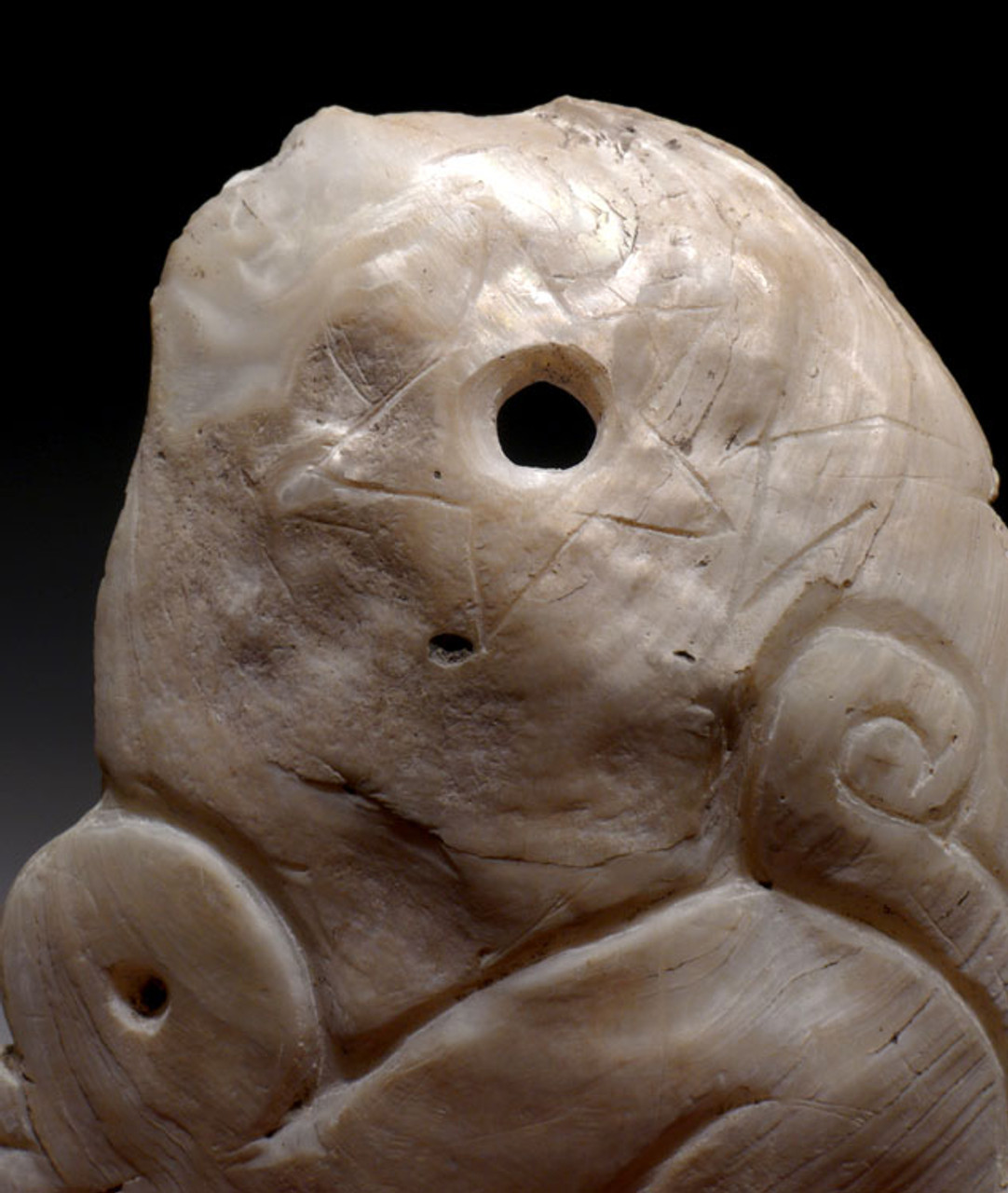Product Description
Because it was the "first" Pre-Columbian culture of the region and venerated by, as well as influenced so many later Pre-Columbian civilizations, objects from the Olmec enigmatic civilization are highly prized amongst seasoned collectors. The sudden appearance of this highly developed culture which produced the mysterious colossal stone heads, still puzzles scientists with many unanswered questions. Where they came from and where they disappeared to remains a mystery today. They were a legendary people even in ancient times and were revered by many Pre-Columbian cultures that followed them. Their artifacts are in strong demand today just as much as they were in the Mayan and Aztec periods.
Ancient astronaut or captive warrior? This is an extremely unusual piece in so many ways. The shell it is made of is a rare, BEAUTIFUL pearl oyster!!! Shell carvings in conch and spondylus from Central American Pre-Columbian cultures are well-known but pearl oyster is very rare in these kinds of artifacts. This is the first time we have offered such a specimen. The carving is unusually large and of what looks like a cross-legged, seated helmeted warrior looking up the the sky. A single drilled hole is on the side of his head and around this hole, a prominent carved star has been engraved onto the side of what looks like a helmet. This symbol is not a commonly used design and adds further intrigue to the meaning of this piece! Much speculation has surrounded several carvings and statues created by the mysterious Olmec people and for good reason. Many examples are impossible to explain and look like detailed space capsules with seated pilots around a complex array of instruments and objects not known to their culture or period. While this carving lacks that kind of detail, there is a certain persona to this piece that makes one wonder what the meaning of it is, especially with the star on the side of the helmet. We call the individual a "warrior" but perhaps the helmet is of another origin? Captives usually were not seated in this manner, cross-legged. It is possible this is a price trophy piece meant for an Olmec ball player champion. The figure could be a ball player rather than a warrior but it appears as if there is some apparatus on the back, evidenced by the odd scroll work above the shoulder. Whatever the meaning, the material, size and Olmec provenance makes this an ESPECIALLY INTRIGUING and unusual, RARE EXAMPLE of luxury art!. With impacted sediment and mineral patina deep in microscopic crevices - traits ONLY seen in AUTHENTIC specimens.
This piece is attributed to the Olmec Culture, the first complex society in Mesoamerica. The Olmecs were an ancient Pre-Columbian civilization that once lived in the tropical lowlands of south-central Mexico.
HISTORY
The Olmec are best known for the enormous helmeted heads they left behind, each carved from of a single massive rock boulder. There is no known Pre-Columbian text that describes or mentions the reason or presence of these megalithic art structures and they have been the subject of much speculation. Some have theorized they were ballplayers but current belief is that they are portraits of rulers. Some have even described the heads as being effigies of ancient astronauts from another galaxy. How they were made or transported by such an early civilization, remains a complete mystery. The heads are all unique in their facial features but all have distinct, common elements in the helmet styles. The Olmecs can be considered the "mother culture" for all subsequent Pre-Columbian cultures of Mesoamerica.
In addition to their influence as the first civilization in Mesoamerica, the Olmecs are credited, or speculatively credited, with many "firsts", including the practice of bloodletting (and perhaps human sacrifice), writing and epigraphy. They are also credited with the invention of the concept of 'zero' and the Mesoamerican calendar, as well as the Mesoamerican ballgame and even perhaps, the compass.
The Olmec culture was first defined as an art style, and this continues to be the hallmark of the culture. Handworks were made in a variety of media such as jade, clay, basalt, and greenstone, for example. Many examples of Olmec art are surprisingly naturalistic. Other art expresses fantastic anthropomorphic creatures, often highly stylized, using an iconography reflective of a religious meaning. Their grasp of human anatomy and emotion is unrivaled by any other Pre-Columbian culture of Mesoamerica.
 US DOLLAR
US DOLLAR
 EURO
EURO
 AUSTRALIAN DOLLAR
AUSTRALIAN DOLLAR
 CANADIAN DOLLAR
CANADIAN DOLLAR
 POUND STERLING
POUND STERLING


















